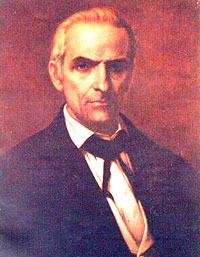2.2.5 José de la Luz y Caballero (1800 – 1862), his philosophical and literary conceptions

Luz y Caballero was the natural follower of Varela’s ideas in philosophy and education. His basic concerns were related to the method of understanding science, which he considered should be both experimental and rationalist, leaving aside the bias of scholasticism.
His conception of the unity of all sciences is very interesting, somewhat divergent from the analytical Cartesian logic that led to the segmentation of problems and, increasingly, of fields of knowledge. This relational thinking is related to the principles of interdisciplinarity, which would emerge at a much later stage of epistemological development. He is also notable in this regard for having championed controversy as a stimulus for the development of knowledge, and for the valid coexistence of different perspectives on phenomena.
Regarding his influence, José Martí would write: “For he was a teacher, and in a single generation, he transformed a people educated for slavery into a people of heroes, workers, and free men. He could have been a lawyer, with a respectful and wealthy clientele, and his homeland was his only client. He could effortlessly display his copious knowledge in the academies, and only reveal what he knew of the truth when it was essential to defend it. He could write in works—for his homeland at least—immortal, what, aiding the sovereignty of his understanding with the piety of his heart, he learned from books and from nature, about the music of creation and the meaning of the world. And he wrote not in books, which reward, but in souls, which tend to forget. He knew everything that was known in his time; but never to teach that he knew it, but to transmit it. He sowed men.”
It is true that José de la Luz y Caballero received a truly encyclopedic education and possessed extensive knowledge and information on various topics in the sciences and arts; but politically, he did not play as active a role as his mentor Varela, although he was not a reactionary or a defender of the most archaic colonial institutions, as he was sometimes unfairly accused.
As a thinker, he was conditioned by his membership in the emerging Creole bourgeoisie, although his identification did not prevent him from noticing the fundamental contradictions of the society of his time. On the one hand, he considered slavery an evil; but he feared its sudden abolition, even with compensation. He also condemned colonial domination but was not openly pro-independence—nor, however, an annexationist movement that sometimes threatened to dominate the landscape of utopias and separatist projects—but rather a reformist, an aspect on which he would reveal certain hesitations.
He was particularly interested in the philosophy of art, in this sense he believed in the existence of an infused gift, which could be cultivated through education but not implanted by it, he considered that art “is rooted in the heart of man and fertilized by the spectacle of the universe.” Specifically in literature he considered the area of the national imagination as inserted in universal literature.
He liked to express his ideas in aphorisms; although – consistent with his scientific ideas – he did not believe in literary precepts and gave equal credit to works from diverse currents, his critical texts were scarce and his literary preferences can be traced to selections and translations of the works of his contemporaries.








